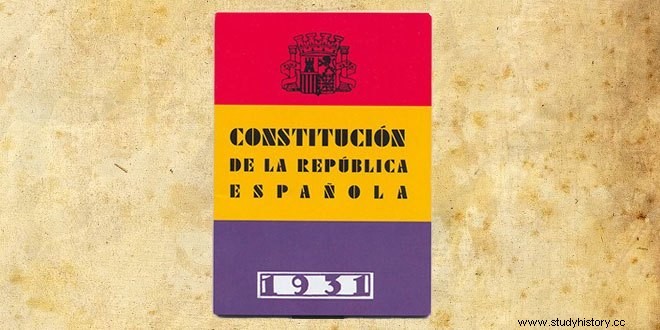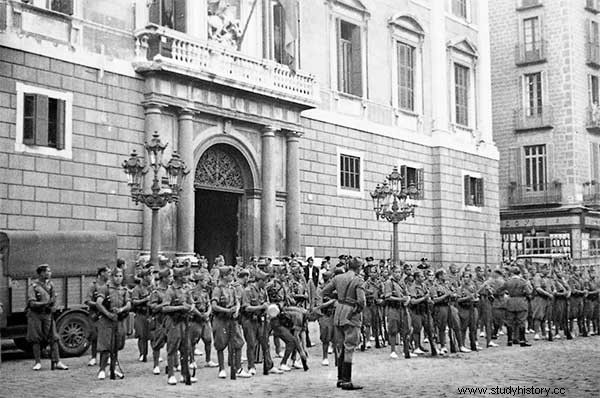Alcalá Zamora and Torres (Niceto). First president of the Second Republic . He was born on July 6, 1877 in Priego (Córdoba). He studied law in Granada, where he was already a lawyer in 1893. He later obtained a doctorate in Madrid.
In 1899, he entered the State Council. In 1905 he was elected deputy for the Carolina district. In 1917, he became Minister of Public Works and, in 1933, Minister of War. In 1930, he left the Liberal Democratic Party and declared himself a Liberal Republican.
Proclamation of the Second Republic
The Second Republic was proclaimed on April 14, 1931, a provisional government was formed presided over by Alcalá Zamora . On June 28, 1931, there were elections to the Constituent Assembly, which the leftists won; the parties of the Right obtained 41 deputies; those of the Center, 119; and those of the Left, 279. On the 14th of the following month, the Constituent Cortes opened; on the 27th, the Chamber was constituted and, on the 28th, the Chamber voted a proposition of confidence in the Provisional Government, with which it endorsed its legitimacy. On October 14, 1931, Alcalá Zamora resigned his position as President of the Government due to the treatment given to the religious issue in the Constitution; he was succeeded by Manuel Azaña y Díaz.
1931 Constitution
On December 9 of the same year, the new Constitution was approved; then Niceto Alcalá Zamora was elected as President of the Republic, who, after swearing the Constitution on the 10th, took office on the 11th. Fights between the political parties immediately began, which would be constant throughout the II Republic; the Right accused the Republicans of having alienated national unity in the Pact of San Sebastian on August 18, 1930.

The Agrarian Reform
In the spring of 1932, Azaña expropriated all the rural estates of the Greatness of Spain (the Greats were 262); he only compensated the improvements that were useful. In the following September, the Agrarian Reform Law was approved, which was not fully applied.
Statute of Autonomy of Catalonia
On September 9, 1932, the Statute of Autonomy of Catalonia was approved by the Cortes, before its project had been approved by referendum in Catalonia on August 2, 1931; the following November 20, elections to the Catalan Parliament were held, which were won by Esquerra Republicana; this upset the Right and the Center. The political, social, labor, economic situation, etc., was getting worse.
1933 elections
When 1933 arrived, there were many conflicts in Spanish society:economic crisis, high unemployment, many strikes, etc.; the events of Casas Viejas on February 24, 1933 further aggravated the situation, which led to the dissolution of the Cortes and the calling of general elections, which were held on November 9, 1933 in which women voted for the first time. in Spain. The right-wing parties won; the distribution of deputies was as follows:Right, 204 deputies- Center 168 and Left, 94.
October Revolution
The result of these elections did not serve to put an end to the myriad of social and political problems of the Republic either, which grew larger and larger, until a general strike, which degenerated into a series of riots, which took place in various provinces; they were especially serious in Asturias and Catalonia during the first fortnight of the month of October 1934; which is why these events are usually called the October Revolution.
Catalonia
In Barcelona, the president of the Generalitat, Companys, from the balcony of the palace of this institution, read a statement that, among other things, said:«In this solemn hour, on behalf of the people and Parliament, the Government that I preside assumes all the faculties of Power in Catalonia, proclaims the Catalan State within the Spanish Federal Republic, […]. Long live the Republic and long live Liberty! Palace of the Generalitat, October 6, 1934.» The Catalan City Council expressed its solidarity with the Generalitat. The army of the Republic residing in Barcelona responded with a declaration of war and throughout the night they shelled and attacked the Palace of the Generalitat and the City Hall and, on the morning of the 7th, the members of the Catalan Government and the City Council had to surrender , and were imprisoned; the buildings of these institutions and others were seriously damaged, in addition to the deaths and injuries.

Asturias
In Gijón the army also had to intervene to quell the revolt, to which was added a flag from the Tercio, which landed on the Musel; in the end the revolutionaries were controlled with their consequent number of dead and wounded; but where the problem reached more serious proportions was in Oviedo; Here, General López Ochoa had to thoroughly employ artillery and aviation to reduce the rebels; On October 12, 1934, the city was conquered, which had been reduced to "a shapeless heap of rubble." The total number of deaths in Asturias was about four thousand.
1936 elections
On the other hand, several governments had succeeded each other since the 1933 elections, until, at the end of 1935, the difficulties in forming a new government led Alcalá Zamora to dissolve the Cortes and call another general election for February 16. of 1936, which were won by the Popular Front (electoral coalition of leftist parties); the result was:Right, 124 deputies; Center, 51; and Left, 278. Thus, Manuel Azaña became President of the Government.
End of Government
Alcalá Zamora (who belonged to the liberal republican right) continued as President of the Republic until the newly constituted Parliament dismissed him on April 7 through a vote of no confidence for having dissolved the Cortes twice within the same term presidential (sanction specified in article 81 of the Constitution). Then Alcalá Zamora went to Paris; he then went to Buenos Aires, where he devoted himself to giving lectures and writing articles for the press, until he died on February 18, 1949.
